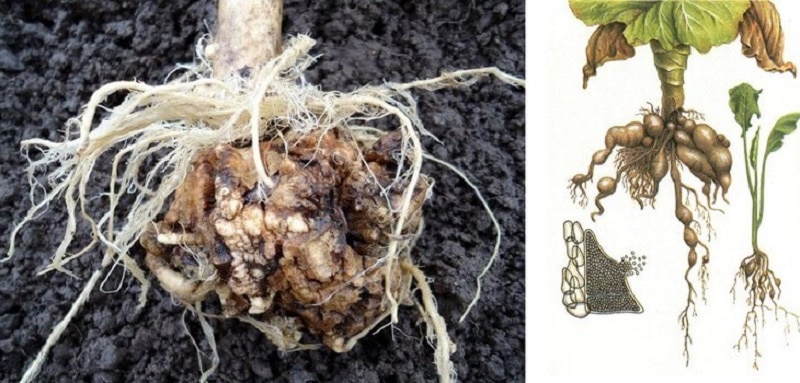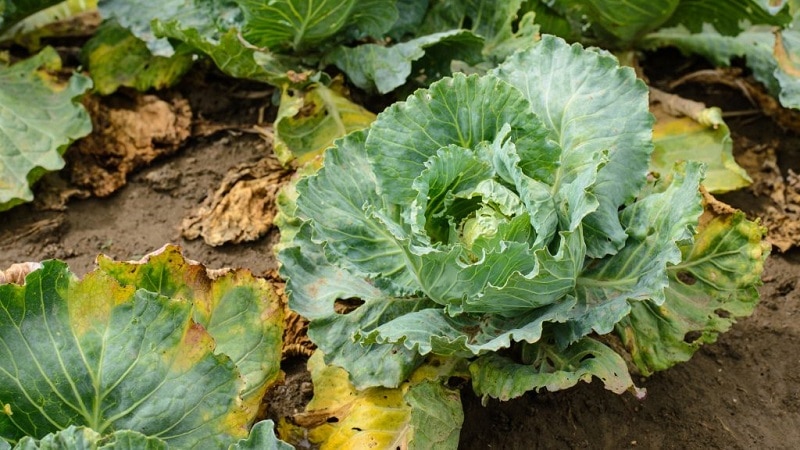Measures to combat clubroot on cabbage
Cabbage clubroot is a dangerous fungal disease that can destroy the entire harvest of cabbage heads in a short period of time, so combating it requires preventive work. To avoid losses, experienced vegetable growers take rapid measures if an infection is detected on plants or in the soil. What to do, if the cabbage is sick kila, you will learn from our article.
What does cabbage affected by clubroot look like?
Clubroot is a common fungal infection that affects plants from the cruciferous family during the growing season. The development of the disease on cabbage is easy to detect by external signs. Despite good care (systematic watering, loosening the soil, fertilizing), the leaves of the plant suddenly begin to turn yellow and fade.
As the disease progresses, thickenings and tuberous growths appear on the roots of the cruciferous crop. On diseased seedlings and healthy plants planted in contaminated soil, the signs of clubroot look different. In the first case, large thickenings form on the central root of the seedlings. In the second, small swellings appear on the lateral roots, resembling beads or icicles.

The root system of infected plants loses the ability to absorb moisture and nutrients from the soil. It gradually acquires a brown color, and by the end of the season it is completely rots. The heads of cabbage that do not have time to ripen fall on their sides. In this case, there is no talk of any harvesting.
Attention! In cabbage infected with clubroot at an early stage of the growing season, the process of formation of dense heads does not occur.
The causative agent of clubroot is the protozoan fungus Plasmodiophora brassicae. It feeds on the cells of cruciferous crops. Spores multiply in a diseased plant and persist in contaminated soil for up to 7 years.
Why does the disease occur?
Heavy, poor, acidic soil and high air humidity are the ideal environment for the development of clubroot. The source of infection is also the remains of diseased plants that were not removed from the garden in time or placed in a compost heap. The reason for the formation of clubroot is the use of fresh mullein, non-compliance with the rules of crop rotation and agricultural technology.
Even healthy seedlings begin to get sick in contaminated soil. Fungal spores enter plant cells with moisture and destroy them. As a result of this process, the underground part of the cabbage is damaged. In the lateral part of the root system, thin hairs die off, and in the central part, thickenings similar to tubers begin to grow.
How to fight clubroot on cabbage
The infection, which is spread throughout the garden by insects, worms, rain and soil cultivation tools, is not easy to get rid of. Before plant cabbage in the beds, experienced vegetable growers take the following actions:
- Cabbage varieties that are resistant to clubroot are selected for planting (Losinoostrovskaya 8, Zimnyaya Gribovskaya 13, Ladozhskaya 22, Moskovskaya late 9).
- Disinfect the soil with Bordeaux mixture.
- Lime the soil and enrich it with mineral components (potassium, calcium, zinc, chlorine, boron).
- Pre-sowing of indicator plants (for example, Chinese cabbage) is carried out. An early ripening crop will allow you to check the soil for infection.
- The seeds and roots of the seedlings are treated with the biological preparation “Fitosporin-M”.
- They cull the seedlings.
- Destroy (burn) infected plants.

Experienced summer residents dig up the beds before planting cabbage, simultaneously enriching the soil with organic matter (humus, compost). During the growing season, weeds are destroyed and the soil is loosened so that the plant roots can breathe. At the end of each season, plant debris is removed from the site and burned.
Important! Measures to combat clubroot will be ineffective if crop rotation and agricultural practices are not followed on the land plot.
How to treat the soil after clubroot in the fall
An area infected with clubroot is not recommended for growing cruciferous crops (including cabbage) for 10 years. To correct this situation, vegetable growers carry out comprehensive work in late autumn to heal the soil.
How to deal with clubroot on cabbage:
- Organic fertilizers (ripened compost, humus) are added to the soil at the rate of 10 kg/sq. m. This improves the structure of the land and increases its fertility. The microflora contained in organic matter will prevent the spread of infection.
- Dolomite flour is added to the acidic soil at the rate of 5 kg/sq. m. This product disinfects the soil and promotes the development of beneficial microorganisms in it that inhibit the activity of fungi.
- Cabbage beds are watered with lime milk, which is prepared from 300 g of slaked lime dissolved in 10 liters of water.
When digging, crushed quinoa and beet tops treated with the biological product “Siyanie-1” are added to the soil. This product contains strains of beneficial bacteria that improve soil quality.
Attention! Adding calcium nitrate to the soil prevents the development of fungal infections.
What can you plant after cabbage infected with clubroot?
It is impossible to get rid of clubroot using chemicals. They suppress the action of the fungus, but do not destroy it completely.

To treat the soil from a dangerous infection, it is recommended to plant every autumn:
- green manure plants;
- nightshade crops (potatoes, tomatoes, eggplants, tobacco, peppers, physalis);
- vegetables from the goosefoot family (spinach, sorrel, chard, beets, etc.);
- plants from the lily family (chives, garlic, hyacinths, onions, etc.).
Sowing cereal crops, which enrich the soil with nitrogen, suppress the growth of weeds and improve the structure of the soil, is effective in the fight against pathogenic microflora.
Attention! Subject to crop rotation rules with the use of green manure plants, nightshades, goosefoot and lily crops, the condition of the contaminated soil improves within 2-3 years.
Even after the measures taken, cruciferous plants begin to be grown in the same place only after control sowing of an early ripening indicator. So as not to give up even for a while cabbage cultivation, summer residents use the technology of high beds.
Conclusion
A dangerous fungal infection cannot be quickly overcome with chemical or folk remedies. However, carrying out preventive measures, observing crop rotation and rules of agricultural technology significantly reduce the risk of clubroot infection of plants and soil.